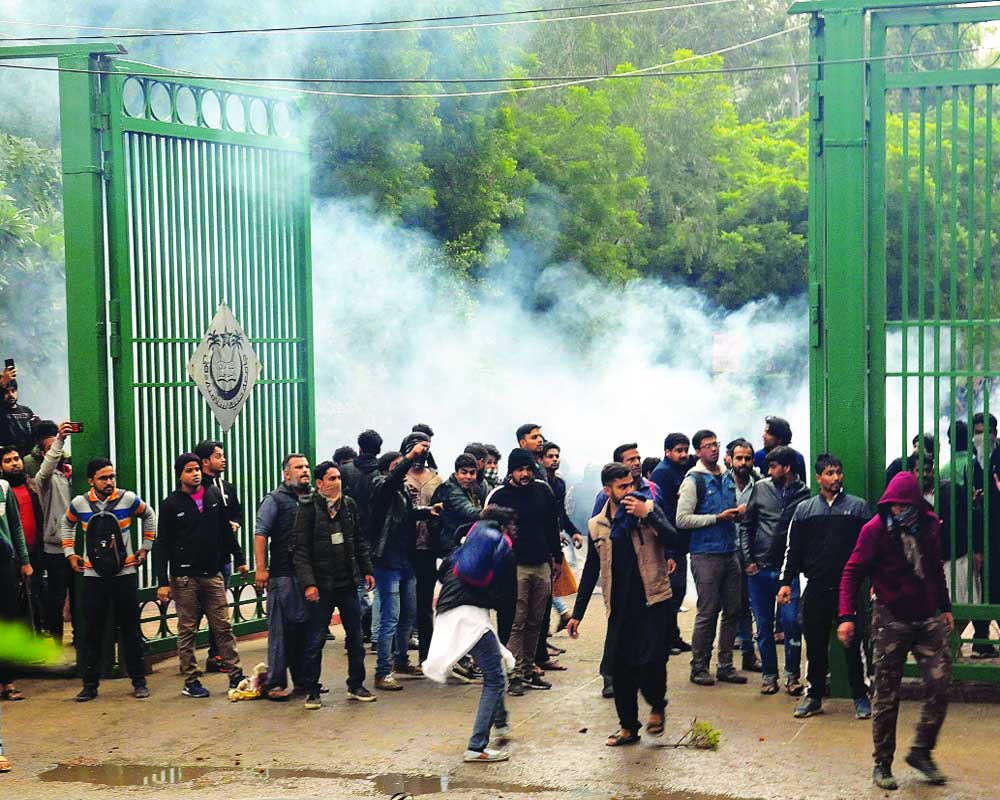The excessive and arbitrary use of violence against protesting students, who just want a voice, is simply unacceptable
It is ironic that on a day the Irish rock band U2 paid a tribute to Mahatma Gandhi’s philosophy of non-violence by singing Ahimsa with AR Rahman in Mumbai, students in Delhi, protesting against the Citizenship Amendment Act (CAA), were subjected to excesses of the most brutal kind in the name of keeping law and order. It is ironic that both the US and France, the two Western nations that are perceived to have been curated by Modi 2.0’s diplomacy, have issued travel advisories to India following the widespread protests on the CAA. It is indeed ironic that the democratic right to dissent is being subjugated by totalitarian clampdowns even at the first response stage. It is disgustingly ironic that the legitimate concerns of an entire student community are being attributed to the alternative “isms” and ideologies that are inconvenient to the establishment. Nobody is condoning the violence and arson that have been resorted to by extreme elements, outsiders even, and necessitates strict action. But to hound and scare the student fraternity as a whole is fascist and makes a mockery of our Constitution. To even classify their largely peaceful congregations as a menace to society is monstrously wrong. As images went viral of the police entering the Jamia Millia Islamia University, ostensibly even without the V-C’s knowledge, barging into libraries and hostels where non-protesting students were going about the normal business of academic life and herding blood-streaked and panicked faces on a cold winter night, the iron fist forgot that it at least needed to wear velvet gloves. That containing violence was one thing, containing students’ right to be heard quite the other. All this naked display of aggression did was to forge a pan-Indian solidarity among students, be it at Aligarh Muslim University and Banaras Hindu University in Uttar Pradesh, IIT and TISS in Mumbai or at campuses in Hyderabad, Chennai, Bengaluru and Kolkata. One of the students of Constitutional law summed it up, saying she was a Hindu but stood at the forefront of an agitation against exclusionary policies that questioned the Indianness of her friends. It is this heart-breaking image that will stay over the rhetoric of political aggrandisement and the Prime Minister’s rather facile dismissal of troublemakers as identifiable by “what they wear.” Many student protesters, therefore, took their shirts off to reveal their janeus, not as a sign of majoritarian guilt but as an assertion of what is right. As a democratic society, students or citizens have the right to protest peacefully and must be accorded the space to do so. Vigilance and safe-keeping don’t mean turning oppressor. The Jamia episode was particularly about jackbooting on presumptions rather than finding out that the arsonists were not students as much. It also raises questions about a differential approach towards students of perceived minority institutions like Jamia and AMU and student protesters elsewhere.
This, then, becomes bigotry of the worst kind, one that actually executes the dystopia of “otherisation.” Even known autocracies have been wise to step back faced with the tsunami of student activism. China did not unleash the Army on Hong Kong students as the world gaze on it changed ever since its misadventure at Tiananmen Square. And during the student-led anti-government protests in Iran, Ayatollah Khamenei told the police to restrain itself even if it meant that activists burnt his posters or tore them apart. We cannot silence students because they do what we have trained them to do, to be fired by idealism, which we fail at, to seek an equitable world and question status quo. They should not be pupeteered but seen as a barometer of our failures. As public movements gather momentum, we must also codify threshold levels for security personnel as to what demands excessive use of force against civilians. There is need for a protocol on escalation, clearly defining situations and the extent of force to be applied, using non-lethal means. It doesn’t matter which political party is in power but the police force simply cannot be politicised. A civil protest has the potential to turn violent but the job of the police is to restore peace in a manner that is mandated by law and with caveats. No police in a democracy can violate basic human rights. As for the identity politics that’s being relentlessly pushed with brute force, the ruling dispensation must realise that it has a mammoth verdict now, doesn’t need tokenisms and can get down to doing what could be its transformative moment, develop India so that we forget that we had been just “crawling” for 70 years. Divisiveness will not dignify even its smallest best efforts.
(Courtesy: The Pioneer)








 OpinionExpress.In
OpinionExpress.In















Comments (0)